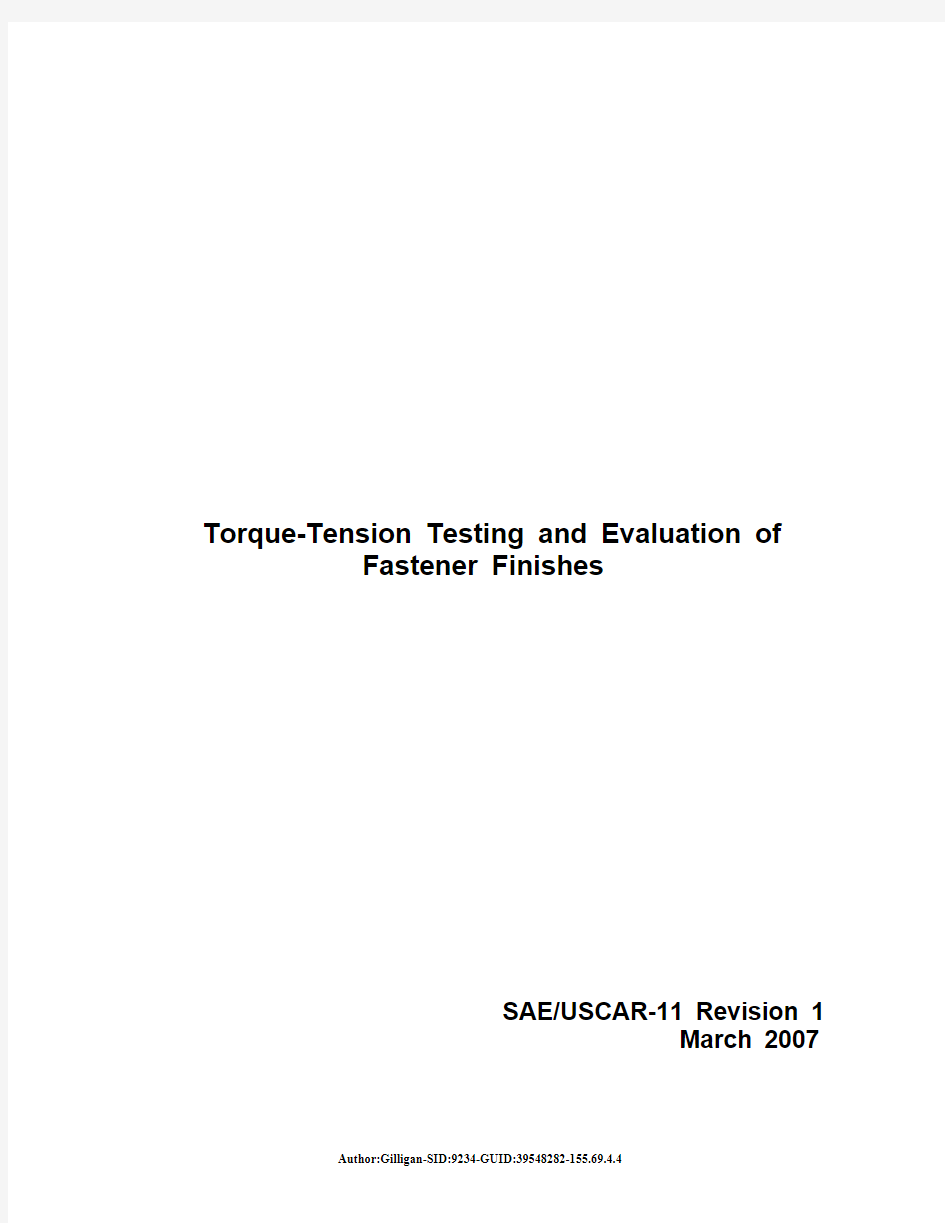

Torque-Tension Testing and Evaluation of
Fastener Finishes
SAE/USCAR-11 Revision 1
March 2007
ISBN: 978-0-7680-1942-1
__________________________________________________________________________________________________________________________________________ The research data, analysis, conclusion, opinions and other contents of this document are solely the product of the authors. Neither SAE International nor the United States Council for Automotive Research (USCAR) certifies the compliance of any products with the requirements of nor makes any representations as to the accuracy of the contents of this document nor to its applicability for purpose. It is the sole responsibility of the user of this document to determine whether or not it is applicable for their purposes.
Copyright ? 2007, USCAR Printed in U.S.A.
SAE/USCAR-11 REVISION 1
Issued 1998-12 Revised 2007-03
TORQUE-TENSION TESTING AND EVALUATION OF FASTENER FINISHES
1. INTRODUCTION:
On some applications of threaded fasteners, it is desirable to control the amount of developed tension when a specified range of torque has been applied or the torque required to develop a specified range of tension. Accurate torque-tension relationships can be achieved only by uniquely defining and controlling the many related assembly parameters. One of the more significant parameters is the frictional characteristic of the selected fastener finish.
2. SCOPE:
This standard provides a test method for determining the torque-tension relationship of a fastener finish as applied to a surrogate screw for the purpose of measuring the frictional characteristic of the fastener finish. The results obtained by this test shall be used as a process control attribute of the fastener finish and shall not be utilized for specific applications.
3. TEST MATERIAL:
3.1 Surrogate Screw:
M10 X 1.5 6e6g surrogate screws conforming to the general requirements of ASME 18.2.3.1M (ISO 4014), except underhead fillet designed such that fillet does not interfere with test washer hole
diameter, and heat treated in accordance with ASTM F568 (ISO 898-1), Property Class 10.9, shall be used to evaluate applicable fastener finishes. Decarburization of the screw threads shall be within the limits defined in SAE J121M (ISO 898-1), Class 3/4 H.
Threads shall conform to ASME B1.13M (ISO 965/1), class 6e6g tolerances and confirmed by ASME B1.3M, System 22 before coating; and class 6h tolerances and confirmed by ASME B1.3M, System 21 after coating. Threads on all surrogate screws shall be rolled. The thread surface shall be free of burrs or other contamination that might affect an accurate determination of the frictional performance of the finish.
The screw length shall be such that a minimum of two full form threads protrude through the test nut when the screw is fully seated against the test washer. The thread length shall be such that a minimum of two full form threads are exposed within the grip length after the bolt is fully seated. Refer to Figure 1 of SAE/USCAR-10, Test for Evaluating the Torque-Tension Relationship of Both External and Internal Metric Threaded Fasteners.
The finish to be evaluated shall be uniformly applied to all surfaces of the surrogate screw using normal production processes and equipment and shall meet all requirements of the individual finish specification.
3.2 Test Nut:
Test nuts shall conform to test nuts defined in SAE/USCAR-10, Test for Evaluating the Torque-Tension Relationship of Both External and Internal Metric Threaded Fasteners.
3.3 Test Washer:
Test washers shall conform to test washers defined in SAE/USCAR-10, Test for Evaluating the Torque-Tension Relationship of Both External and Internal Metric Threaded Fasteners.
4. TEST EQUIPMENT:
Test Equipment shall conform to test equipment defined in SAE/USCAR-10, Test for Evaluating the Torque-Tension Relationship of Both External and Internal Metric Threaded Fasteners.
5. TEST PROCEDURE:
5.1 Loosely assemble the surrogate screw, the appropriate test nut and test washer into the fixture. The parts are to be installed such that the surrogate screw can be driven by the drive tool and the screw’s bearing surface rotates against the test washer. The test washer shall be prevented from turning during rundown. Adjust the grip length of the test fixture such that when the parts are fully seated, the surrogate screw protrudes a minimum of two full form threads through the test nut.
5.2 Set the power tool shut off at a tension value of approximately 1.0% greater than the specified clamp load value of 3
6.1 kN, 75% of proof load for a M10 X 1.5 property class 10.9 fastener. Tighten the joint by driving the surrogate screw with the power tool at a continuous speed of 10 to 40 RPM. Both torque and tension are to be continuously recorded during rundown. New components shall be used for each test.
6. DATA ANALYSIS:
6.1 Sample Size:
The sample size shall be as specified or as agreed to between the manufacturer and purchaser.
6.2 Results:
Torque shall be statistically analyzed to produce mean and 3 sigma limits at the specified tension. Control charts of the test results shall also be maintained for each applicable fastener finish. The torque necessary to develop the specified tension shall meet the applied torque requirements of the individual finish specifications.
7. REFERENCES:
ASME B18.2.3.1M (ISO 4014) ASME B18.2.4.1M (ISO 4032) ASME B1.13M (ISO 965/1) ASME B1.3M
ASTM A563M (ISO 898/2) ASTM F568 (ISO 898/1)
SAE J121M (ISO 898/1)
SAE/USCAR-10
8. KEYWORDS:
Torque, Tension, Clamp, Load